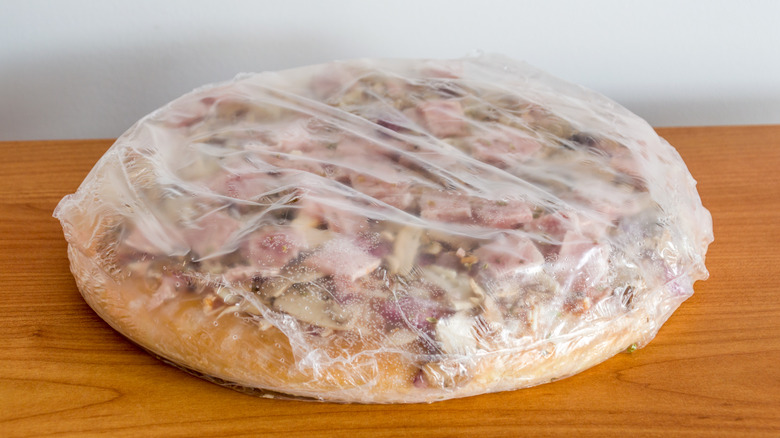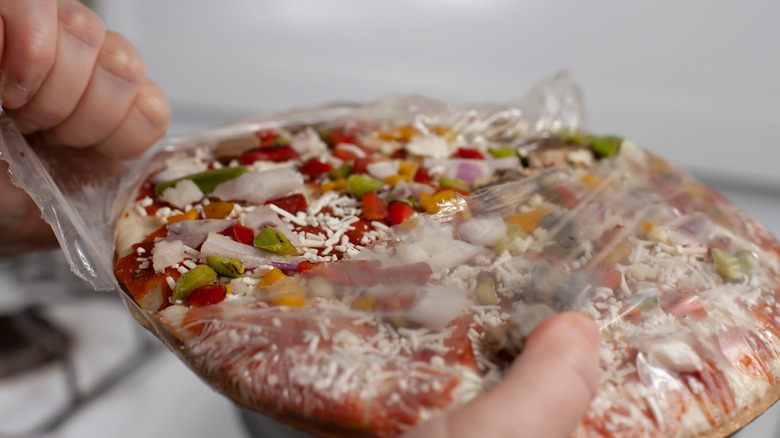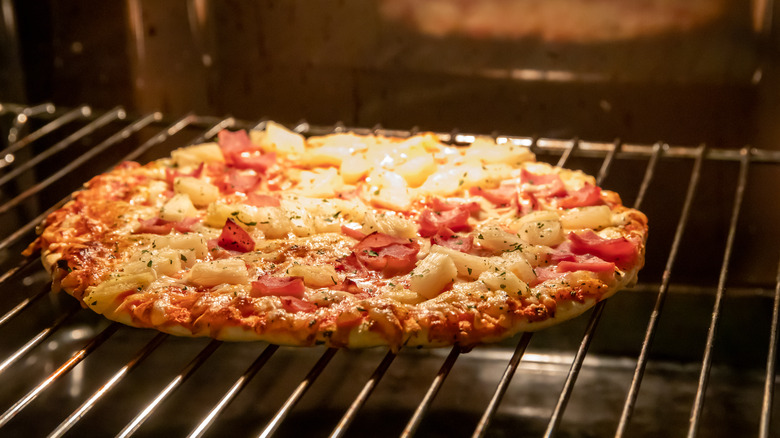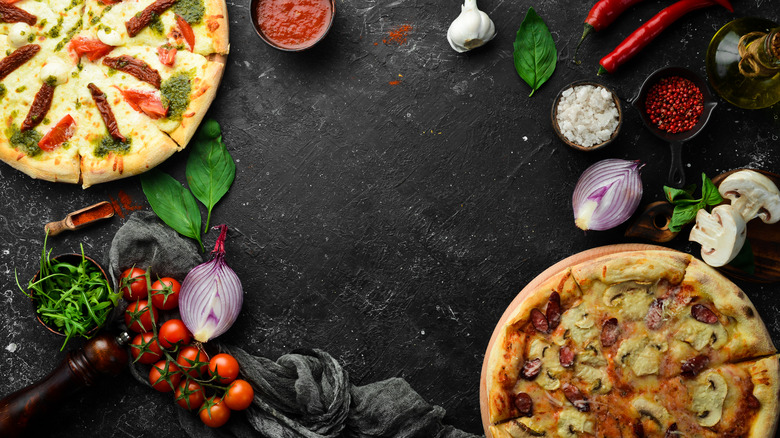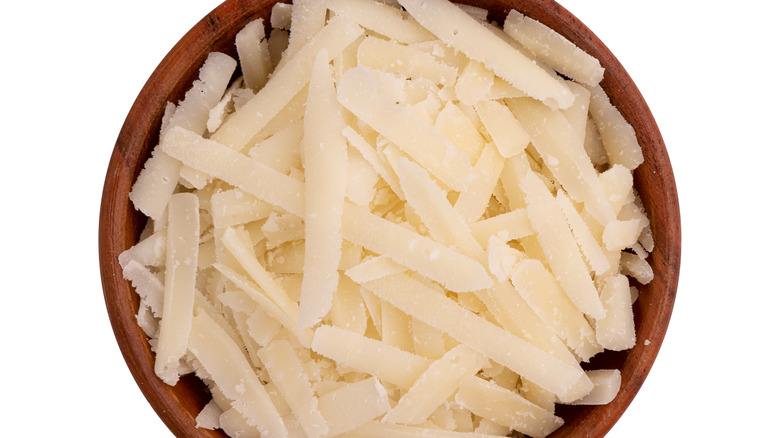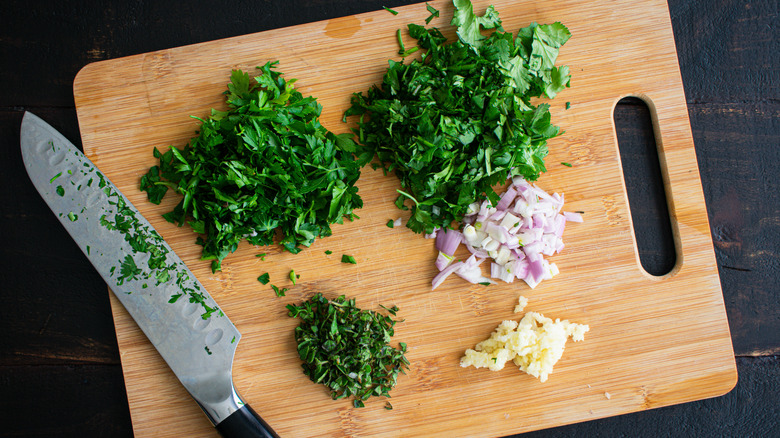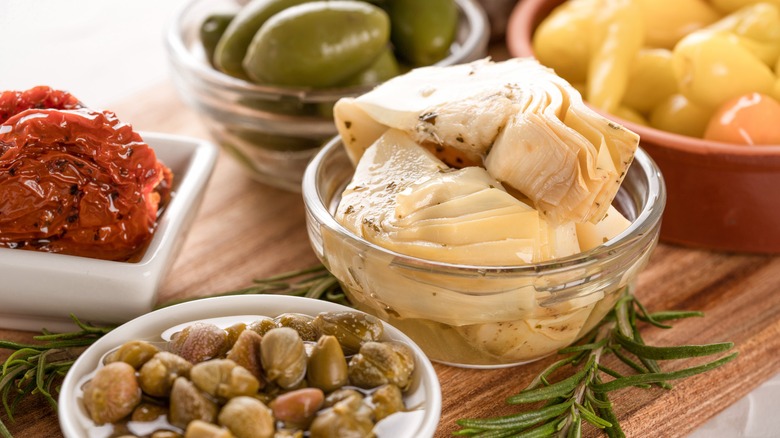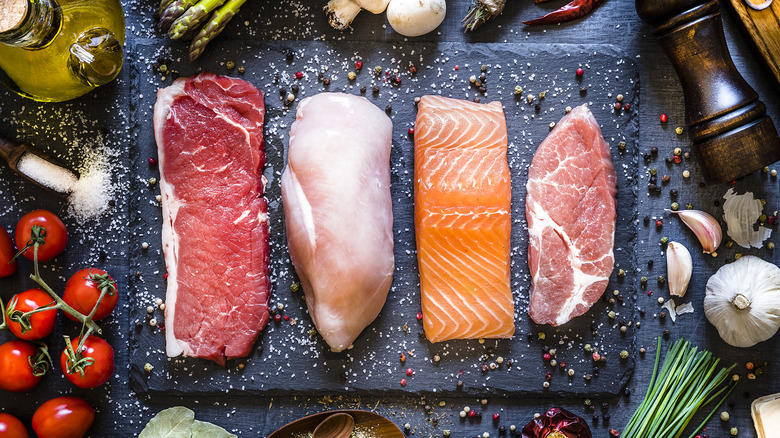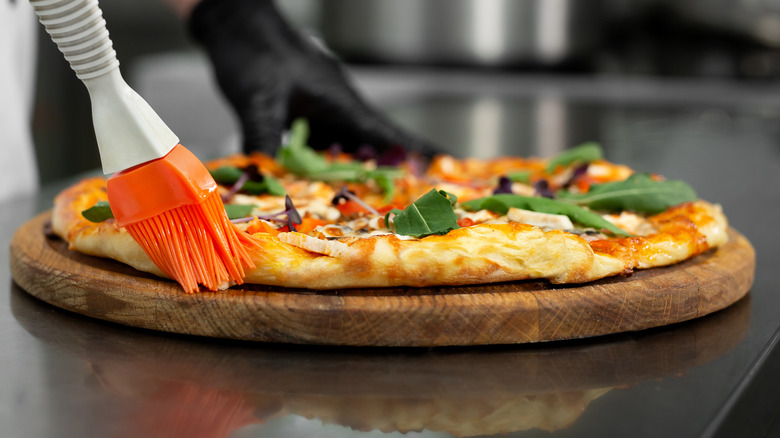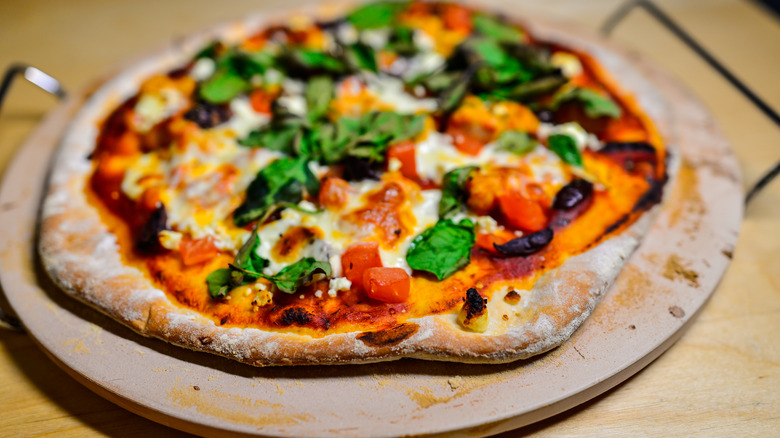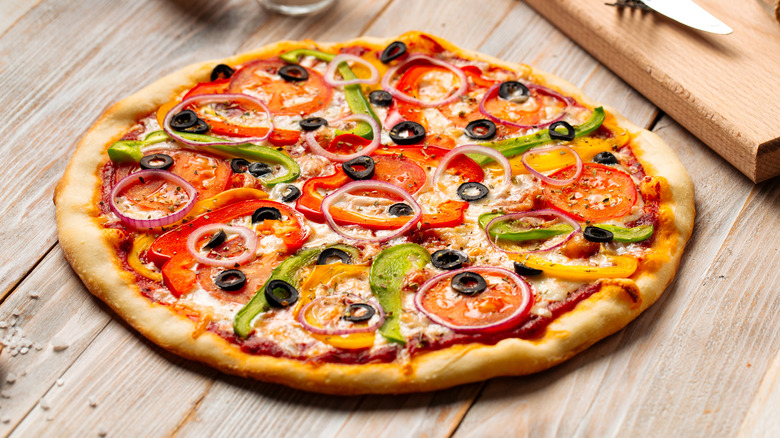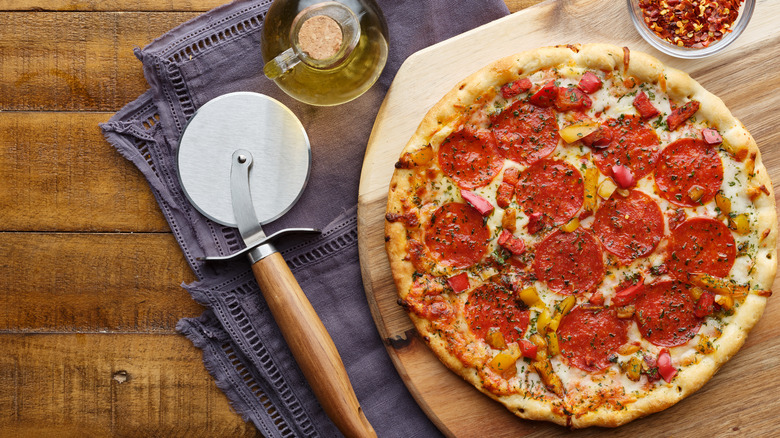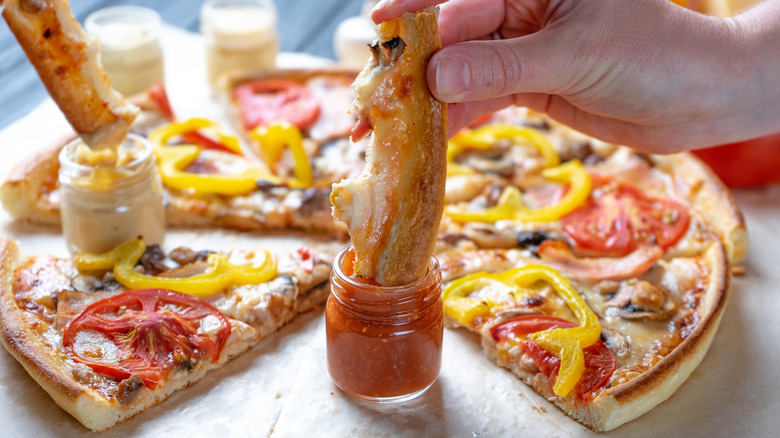Frozen Pizza Mistakes You Should Avoid At All Costs
Pizza is a perfect food. It combines gooey melted cheese with tangy tomato sauce all layered on top of a crispy-chewy crust. Not only does it taste good, but it's inexpensive, customizable, and available all over the world in its many forms. Everybody loves pizza; from hungry college students ordering delivery to couples on date night dining in upscale pizzerias to tired parents throwing a frozen pizza in the oven, there is a pizza for every style and budget. Pizza can be vegetarian, gluten-free, dairy-free, or vegan. It doesn't matter what dietary restrictions you follow; there is always a way to make pizza part of the menu.
If you are hungry for pizza but don't have time to make it and don't feel like dealing with delivery, then frozen pizza can step in and really satisfy those cravings. Nowadays, bland basic frozen pizzas have stepped up their game and become a viable option for pizza night. Despite the leaps and bounds frozen pizza has made over the years, there are a few tricks and tips to make it even better. The easiest way to make it better is to learn the mistakes you should avoid at all costs to ensure your frozen pizza delivers flavor every single time.
Defrosting it before cooking it
A common mistake many home chefs make with frozen pizza is defrosting it before baking it. It's an easy mistake because it makes sense to defrost food before placing it in the oven. Home chefs know not to put frozen steaks or frozen fish in the oven without defrosting them first. And anyone who has ever forgotten to defrost a turkey at holiday time knows that a frozen bird doesn't make it to the Thanksgiving table. So those that learned the hard way to defrost foods before cooking might apply that same idea to frozen pizza. While it may seem against common sense to place a frozen pizza in a hot oven, it is actually the right way to cook it. It says so right on the box, but most of us don't read the instructions.
The main reason not to defrost a frozen pizza is that defrosting the pizza on the counter, as many are prone to do, increases the chance of foodborne illness. The USDA explains that it only takes two hours for bacteria to begin to grow in foods. So defrosting your frozen pizza on the counter is a recipe for disaster. It's best to place the frozen pizza directly into the hot oven or leave it in the refrigerator if you plan to use it within a few hours.
Not cooking at the right temperature
The best way to cook pizza is at a high temperature. Pizza ovens at pizzerias and home pizza ovens reach temperatures up to 950 degrees Fahrenheit. Most standard kitchen ovens do not reach such high temperatures. You can cook pizza at home at the highest temperature possible in your home oven; for most standard home ovens, the highest temperature is around 475 to 500 degrees Fahrenheit.
The reason pizza is cooked at such a high temperature is the crust. A short cook time at a high temperature is going to transform the doughy crust to crispy-chewy perfection. If pizza is cooked for longer at a lower temperature, it risks becoming soggy without any texture. Each frozen pizza brand has specific cooking instructions and directs diners to cook pizzas anywhere between 400 to 425 degrees Fahrenheit. But you can safely skip those instructions and turn up the temperature and cut the cooking time. If you added extra toppings, you could always finish cooking the pizza on broil to make sure the top is cooked without worrying about overcooking the crust.
Another option is to grill frozen pizzas. Gas grills are the best option for grilling frozen pizzas because you can control the temperature and ensure it cooks at high heat.
Only using the frozen toppings
One simple way to take a frozen pizza up a notch is to add your own toppings. Frozen pizzas come with frozen toppings, which is a good place to start, but why not add more flavor and texture by adding fresh toppings? Slices of crunchy bell peppers, umami-rich mushrooms, salty olives, and tangy onions can take your boring frozen pizza and make it pizza night worthy. You can add freshly cut vegetables and goodies straight to the frozen pizza. The high heat softens them and adds some much-needed texture.
If you really want to impress your dining companions, take it a step further and caramelize some onions to top your frozen canvas. Caramelized onions are somehow sweet and savory at the same time and make a tasty addition to a frozen pie. Likewise, slow-roasted red peppers, thin slices of grilled zucchini, and eggplant add a gourmet touch. Plus, adding fresh veggies can turn your frozen pizza into a healthy meal.
Not adding extra cheese
The best part about pizza is the cheese, so why not add more of a good thing? Most frozen pizzas don't have enough cheese, but that is an easy fix. Adding more cheese is an excellent way to amp up the taste and make your frozen pizza experience more satisfying.
Start by choosing the right cheese. Most frozen pizzas use a simple grated mozzarella. Some of the new gourmet frozen pizzas use frozen slices of fresh mozzarella. But mozzarella isn't the only option. You can keep the Italian flavors using cheeses like Parmesano Reggiano, Pecorino, or Fontina. Or use soft cheeses like goat cheese or ricotta. Crumbly cheeses like feta and tangy blue cheese add a unique texture and robust flavor.
When choosing your cheese, it is always a good idea to match your cheese with your toppings; if you are making a frozen pizza with salami and peppers, grate on some Spanish manchego. A taco pizza is best with a cheddar blend or a Mexican cheese like Oaxaca or queso fresco. And a smoked gouda complements a BBQ chicken pizza perfectly.
Forgetting to add more herbs and spices
Prepared packaged foods like frozen pizza are filled with sodium and preservatives, so extra salt isn't usually necessary. But frozen pies usually lack herbs and spices, which are key to adding more depth of flavor. Adding dried herbs like oregano, basil, parsley, and thyme are good choices for frozen pizzas. A premixed Italian seasoning blend is another excellent choice to sprinkle on. Adventurous pizza lovers might enjoy more complex spices like za'atar or dried Calabrian chilies.
Don't forget about fresh herbs like Genovese basil, rosemary, and Italian parsley, which all can transform a boring frozen pie with a fresh burst of flavor. A freshly made gremolata with Italian parsley, garlic, and lemon zest is an excellent choice, too. When choosing the herbs and spices to add, keep in mind that dried herbs and spices have a stronger flavor than fresh ones. And the best time to add fresh herbs is after the pizza has come out of the oven to avoid those bright green leaves from turning brown.
Using too many wet toppings
One mistake you should avoid is adding too many wet toppings to your frozen pizza. Moisture is the enemy of pizza and will turn it into a soupy, soggy mess. So when adding wet toppings like marinated artichokes, sun-dried tomatoes, and olives, make sure to set them aside and squeeze them with a paper towel to dry them.
Pineapple, the controversial pizza topping that divides pizza lovers everywhere, is best fresh rather than canned. But since it's only available at certain times of the year, canned pineapple is fine to use. If you are one of the many supporters of pineapple on pizza and love the sweet taste that it brings to a pie, then opt for canned pineapple in chunks or rings instead of crushed pineapple. Crushed pineapple is great for daiquiris and smoothies, but it's impossible to get the moisture out, so avoid it on pizza.
Adding raw protein
Not only can you add fresh veggies and extra cheese to your frozen pizza, but you can add more protein, too. Extra pepperoni, salami, and Canadian bacon will improve your pizza. But don't stop at the classic meaty toppings; try adding some other meats to upgrade your frozen pizza. Shredded rotisserie chicken or leftover pulled pork are great additions to pizza. Bacon and guanciale add some salty, smoky flavor. Spicy 'nduja salami is a good choice for heat seekers. Raid your freezer and add some frozen meatballs or shrimp to remake your frozen pizza.
The key to adding extra protein to frozen pizza is to make sure the protein is cooked. Classic pizza toppings like pepperoni, salami, and prosciutto are either cured, salted, or smoked, making them safe to add directly to the pizza. But other proteins must be cooked before adding them. The short time in the oven, even at extreme heat, is not enough to ensure they are completely cooked. So if you use ground beef for taco pizza, cubed chicken for Thai pizza, or strips of calamari for a seafood pizza, ensure the protein is fully cooked to avoid foodborne illness.
Not buttering up the crust
The common denominator that all frozen pizzas share is a boring crust. The sauce is always too far from the crust, and the toppings are even further, leaving a boring, tasteless wedge of cooked dough. But there are ways to make the crust a star player too, and you probably already have them in your kitchen. Start with butter; it makes everything better. Butter is the little restaurant secret that adds a rich flavor to everything, including pizza crust.
Take a pastry brush and dip it in melted butter, then brush the crust before baking the pizza. You can add fresh garlic to the butter or a pinch of garlic salt for an elevated frozen pizza crust. Everything bagel seasoning is another good choice for the crust. The melted butter helps the seasoning stick. If you like the heat, add some crushed red pepper to the butter for a fiery pizza crust. The possibilities are endless. Just look in your spice cabinet for some inspiration.
Underestimating the power of the pizza stone
Pizza stones are an essential piece of equipment for anyone that loves making pizza. From homemade pizza to frozen pizza to leftover pizza, a pizza stone is the only way to heat pizza. That's the case because they are made from either stone or ceramic material, and their sole purpose is to absorb and radiate heat allowing the pizza to cook evenly.
The trick to using a pizza stone to cook frozen pizza is to let the pizza rest in the refrigerator for an hour before baking it. This way, the pizza is still in the safe zone but not completely frozen because placing a frozen pizza on a preheated stone could cause the stone to crack due to the rapid temperature change, otherwise known as thermal shock.
The added benefit of having a pizza stone is that you can use them for more than just pizza. Roasting vegetables and baking bread and cookies are just some of the many ways to use a pizza stone.
Not giving the pizza a rest
Everybody needs to take a rest, and pizza is no different. Letting a cooked pizza rest allows it to firm up and all of the melted cheese and cooked toppings to solidify. If you cut into a piping hot pizza, the toppings and cheese are so hot they will just slide right off, making a big mess of your lovely pizza pie. Plus, cutting into the cooked pizza causes the hot melted cheese to stick to the pizza cutter, which makes it harder to cut. So wait two minutes before cutting into your pizza. Don't worry; your pizza will still be hot and tasty. And you get to enjoy it without burning and blistering the roof of your mouth, a predicament that any impatient pizza lover has had.
Use those few minutes the pizza is cooling to grate some fresh parmesan, pluck some fresh basil leaves, and dig through your spice rack for crushed red pepper so when your pizza is ready, you are too.
Cutting it with a dull kitchen knife
Do not cut a pizza with a dull knife. Ideally, you should not even have a dull knife in your kitchen. You should sharpen your knives regularly or, better yet, invest in a pizza cutter. There are three different types of pizza cutters: the traditional round cutter, the mezzaluna blade that is a half circle, and pizza scissors. If you are on a budget, keep it simple and opt for a traditional round-bladed pizza cutter. These are the least expensive option and work great on frozen, homemade, or restaurant pizzas.
If you are concerned about adding yet another single-use kitchen gadget to your already overstuffed kitchen drawers, then you will be pleased to know that pizza cutters have more uses than just cutting pizza. You can use your pizza cutter to chop herbs, cube meat, slice off crusts, and cut brownies into perfect squares.
Not getting saucy
Most frozen pizzas don't have enough sauce, which is a strategic move on the part of the manufacturers because too much sauce will make the pizza soggy when it cooks. Frozen pizza makers have learned that a thin layer of sauce freezes better and subsequently cooks better from frozen. Because of this, frozen pizza can have a dry texture and lack the flavor that acidic tomatoes bring. So adding extra sauce in the form of dipping sauces is one way to make frozen pizza taste better.
Marinara sauce is the classic dipping sauce, and you can even layer it on top of your frozen pizza, similar to Detroit-style pizza. Ranch dressing is another popular dipping sauce for pizza. It is tangy and creamy and complements any style of pizza. Bright green pesto, smoky barbecue sauce, spicy sriracha, and pungent aioli all make excellent dipping sauces to make the most of your frozen pizza. If you like the sweet and hot flavor combination, you will love dipping your pizza slices in a hot honey sauce.
Don't make the mistake of serving your frozen pizza without some extra sauce to make it better. Frozen pizza may not be the best pizza, but it's still pizza, and with some sauces on the side, it levels up and tastes better.
